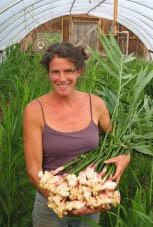Melissa Bahret of Old Friends Farm in Amherst, Massachusetts, saw that her greenhousewas sitting idle in the late spring and summer, after her vegetable starts were in the ground or sold to customers.
She and her business partner, Casey Steinberg, were looking for new ways to use the space and to complement the flowers, salad greens, garlic, and shiitake mushrooms raised and sold at farmers markets, restaurants, to florists, and for weddings.
They settled on trying ginger because it was not available locally, was in high demand as a kitchen staple, and commanded a good price. Better still, the transportation costs were nil when compared to ginger flown in from far away—this appealed to them and to their customer base.
Bahrat got two Farmer Grants to study and test this new crop, grown from mother roots from Biker Dude Organic Ginger Farm in Pahoa, Hawaii, and she reports that harvest began 152 days after planting—roughly the end of August—and continued for six weeks. She harvested plants in the young-stalk stage, not the mature root; in this stage, ginger is white with pinkish streaks, tender in comparison to mature roots, and can be used in teas and soups much like lemongrass.Young ginger also offers has more salable components, so little is wasted.
The ginger sold for $20 a pound at the market, and in the first year the farm produced 209 pounds and made $4,180. During that first season, they also offered tours that attracted 40 people. One of them was Elizabeth Schwab, a food writer for the Boston Globe, who then did a story on their new ginger endeavor. After the second year of funding, Bahret and Steinberg also wrote an article for Growing for Market called “Spice it up! Grow Ginger!” where they shared the cultivation details.
While the investment of $6,391 was more than income during the first year, the increase in new customers was priceless. But for the crop to be viable, they had to find ways to reduce costs, so they spent the second Farmer Grant award comparing the greenhouse system to an in-ground hoop house practice. for $20 a pound at the market, and in the first year the farm produced 209 pounds and made $4,180.
“Using the high tunnels was a drastic profit improvement over growing in the greenhouse,” Bahret says. In fact, the greenhouse ginger lost money while the hoophouse ginger earned almost $3,000 in income over expenses, mostly because of differences in heat and labor.
"In the unheated high tunnel," Bahret says, “we prepare the soil beds just like preparing for potatoes.”
Though still learning about the best ginger cultivation practices, the Old Friends Farm owners continue to plant a crop each year: “People love the ginger,” says Bahret, and customers are willing to pay extra for it: “It’s a much higher grade than typical store ginger. We’re still working on streamlining our methods to increase profits.
“SARE helped us curb the costs of trying out an initial idea, which was really helpful for this endeavor,” she says. “Many people still call responding to the SARE article, although many of the methods we used then we do not use now. We’ll be creating a Northeast Ginger Growers website group this winter for more activesharing of ideas and information.”
